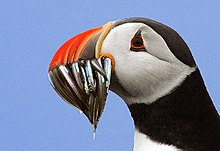Sand eel

Sand eel or sandeel is the common name used for a considerable number of species of fish. Most of them are sea fish of the genera Hyperoplus (greater sandeels), Gymnammodytes or Ammodytes. Many species are found off the western coasts of Europe from Spain to Scotland, and in the Mediterranean and Baltic Seas.
The three genera listed above all fall within the family Ammodytidae, the sandlances. Members of these genera found in other oceans are not usually called Sand Eels, and species from other parts of the world that are known as sandeels are usually less closely related. None of the Sand Eels are related to the true eels.
Sandeels are an important food source for seabirds, including puffins and kittiwakes.
Habitat
A preferential habitat is a seabed floor, where there is a relatively smooth bottom environment of gravelly sand; an example of this prime habitat is the floor of the Sea of the Hebrides.[1] Sandeels typically burrow in the sand of seabeds to escape from predators.
Commercial fishing
Traditionally they have been little exploited for human food, but are a major target of "industrial fishing" for animal feed and fertilizer. Increasing fishing of them is thought to be causing problems for some of their natural predators, especially the auks which take them in deeper water.
An instance of this was the RSPB linking a population crash of sea birds in the North Sea to fishing for sand eels. This led to political pressure for the closure of this fishery; the seabird populations subsequently improved. However, a second population crash of seabirds which occurred with no effect on the stocks of sand eel, cast doubt on this link.[citation needed]
See also
Reference line notes
- ^ C.Michael Hogan, (2011) Sea of the Hebrides. Eds. P. Saundry & C.J.Cleveland. Encyclopedia of Earth. National Council for Science and the Environment. Washington DC.
External links
- Eurofish: "Sandeel provide the backbone for industrial fishery"
- Greenpeace: "Industrial "Hoover" Fishing"
